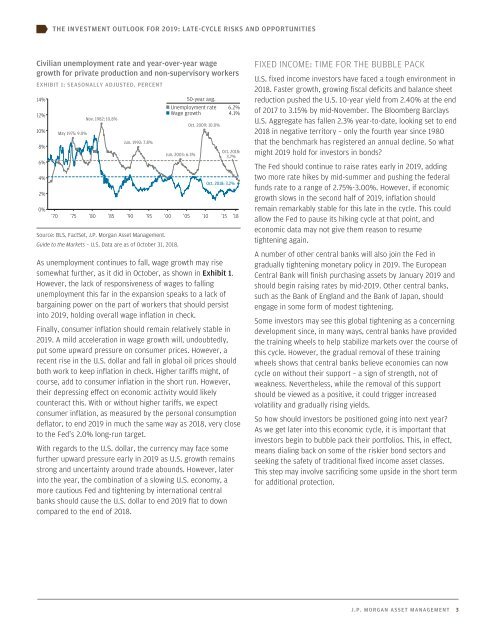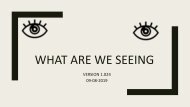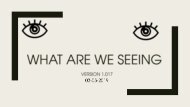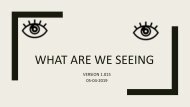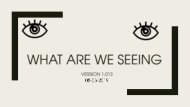You also want an ePaper? Increase the reach of your titles
YUMPU automatically turns print PDFs into web optimized ePapers that Google loves.
THE INVESTMENT OUTLOOK FOR 2019: LATE-CYCLE RISKS AND OPPORTUNITIES<br />
Civilian unemployment rate and year-over-year wage<br />
growth for private production and non-supervisory workers<br />
EXHIBIT 1: SEASONALLY ADJUSTED, PERCENT<br />
14%<br />
12%<br />
10%<br />
8%<br />
6%<br />
4%<br />
2%<br />
0%<br />
May 1975: 9.0%<br />
Nov. 1982: 10.8%<br />
Jun. 1992: 7.8%<br />
50-year avg.<br />
• Unemployment rate<br />
• Wage growth<br />
Jun. 2003: 6.3%<br />
Oct. 2009: 10.0%<br />
6.2%<br />
4.1%<br />
Oct. 2018:<br />
3.7%<br />
Oct. 2018: 3.2%<br />
’70 ’75 ’80 ’85 ’90 ’95 ’00 ’05 ’10 ’15 ’18<br />
Source: BLS, FactSet, J.P. Morgan Asset Management.<br />
Guide to the Markets – U.S. Data are as of October 31, 2018.<br />
As unemployment continues to fall, wage growth may rise<br />
somewhat further, as it did in October, as shown in Exhibit 1.<br />
However, the lack of responsiveness of wages to falling<br />
unemployment this far in the expansion speaks to a lack of<br />
bargaining power on the part of workers that should persist<br />
into 2019, holding overall wage inflation in check.<br />
Finally, consumer inflation should remain relatively stable in<br />
2019. A mild acceleration in wage growth will, undoubtedly,<br />
put some upward pressure on consumer prices. However, a<br />
recent rise in the U.S. dollar and fall in global oil prices should<br />
both work to keep inflation in check. Higher tariffs might, of<br />
course, add to consumer inflation in the short run. However,<br />
their depressing effect on economic activity would likely<br />
counteract this. With or without higher tariffs, we expect<br />
consumer inflation, as measured by the personal consumption<br />
deflator, to end 2019 in much the same way as 2018, very close<br />
to the Fed’s 2.0% long-run target.<br />
With regards to the U.S. dollar, the currency may face some<br />
further upward pressure early in 2019 as U.S. growth remains<br />
strong and uncertainty around trade abounds. However, later<br />
into the year, the combination of a slowing U.S. economy, a<br />
more cautious Fed and tightening by international central<br />
banks should cause the U.S. dollar to end 2019 flat to down<br />
compared to the end of 2018.<br />
FIXED INCOME: TIME FOR THE BUBBLE PACK<br />
U.S. fixed income investors have faced a tough environment in<br />
2018. Faster growth, growing fiscal deficits and balance sheet<br />
reduction pushed the U.S. 10-year yield from 2.40% at the end<br />
of 2017 to 3.15% by mid-November. The Bloomberg Barclays<br />
U.S. Aggregate has fallen 2.3% year-to-date, looking set to end<br />
2018 in negative territory – only the fourth year since 1980<br />
that the benchmark has registered an annual decline. So what<br />
might 2019 hold for investors in bonds?<br />
The Fed should continue to raise rates early in 2019, adding<br />
two more rate hikes by mid-summer and pushing the federal<br />
funds rate to a range of 2.75%-3.00%. However, if economic<br />
growth slows in the second half of 2019, inflation should<br />
remain remarkably stable for this late in the cycle. This could<br />
allow the Fed to pause its hiking cycle at that point, and<br />
economic data may not give them reason to resume<br />
tightening again.<br />
A number of other central banks will also join the Fed in<br />
gradually tightening monetary policy in 2019. The European<br />
Central Bank will finish purchasing assets by January 2019 and<br />
should begin raising rates by mid-2019. Other central banks,<br />
such as the Bank of England and the Bank of Japan, should<br />
engage in some form of modest tightening.<br />
Some investors may see this global tightening as a concerning<br />
development since, in many ways, central banks have provided<br />
the training wheels to help stabilize markets over the course of<br />
this cycle. However, the gradual removal of these training<br />
wheels shows that central banks believe economies can now<br />
cycle on without their support – a sign of strength, not of<br />
weakness. Nevertheless, while the removal of this support<br />
should be viewed as a positive, it could trigger increased<br />
volatility and gradually rising yields.<br />
So how should investors be positioned going into next year?<br />
As we get later into this economic cycle, it is important that<br />
investors begin to bubble pack their portfolios. This, in effect,<br />
means dialing back on some of the riskier bond sectors and<br />
seeking the safety of traditional fixed income asset classes.<br />
This step may involve sacrificing some upside in the short term<br />
for additional protection.<br />
J.P. MORGAN ASSET MANAGEMENT 3


